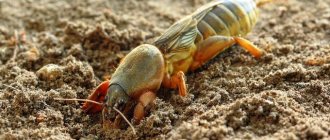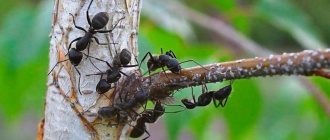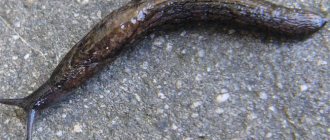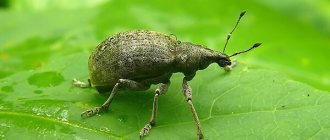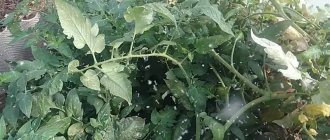Wireworms are the larvae of all pests that belong to the genus of click beetles (Elateridae). In appearance, they are worms, sometimes reaching 45 mm in length, with powerful nodules and a body as hard as wire.
Stages of development:
- May-July: beetles (imago) lay eggs (1st stage).
- After 20 days, larvae appear from the laid eggs (stage 2 lasts from 2 to 5 years).
- After at least 24 months of life (July-August), the larva becomes a pupa (3rd stage - 14-21 days).
- August-September: the pupa turns into a beetle and overwinters in a cradle.
- From April next year, the beetles migrate, looking for conditions favorable for reproduction.
The larvae live in the top layer of soil (found at a depth of up to 15 cm), and before autumn frosts they burrow to a depth of up to 60 cm.
How dangerous are these larvae?
Many believe that the favorite delicacy of these worms is new potatoes. But wireworms do not disdain any parts of the plant: the root system, the lower parts of the stems, fruits, seeds. They can also switch to root vegetables such as carrots, rutabaga, beets, turnips, radishes, etc.
In their absence, they can settle in the juicy roots of cabbage, tomatoes, eggplants, onions, peppers and other vegetable crops, and the bulbs of decorative flowers (lilies, peonies, gladioli). Plants begin to wither, fruits lag behind in growth, lose their presentation, and are poorly stored.
The main signs of the appearance of wireworms on plants are:
- wilting or sudden yellowing of plantings, often individual bushes, and not all specimens in a row;
- causeless drying of mature plants, which are easily removed from the ground;
- leaf lethargy;
- noticeable growth retardation.
If you remove the root crops, you can easily notice dark winding passages in them, dots from pests, and sometimes even the culprits of the damage themselves.
Brief description of the pest
The adult individual (click beetle) is small in size, reaching only 1.5-2 cm in length. Its distinctive feature is that the insect is capable of making a characteristic click when turning over. During the summer, the female is capable of laying an average of 100-150 eggs in the soil, from which the larvae of the harmful wireworm emerge.
2-4 year old worms are characterized by a segmented body with numerous legs. Their length can vary up to 2-3 cm, and adult specimens have a hard shell of chitin, which does not allow them to simply be crushed by hand.
If you look at a photo of a wireworm, you can see that in appearance they resemble small pieces of wire (which is why they got that name).
Life cycle of individuals
The larvae themselves overwinter in the ground at a depth of about half a meter, although the beetles are able to burrow only to 20-30 cm. The pupation process occurs in August, for this purpose depressions are made in the ground. Young beetles emerge from the pupae and remain to overwinter in the ground. In the spring they fly out and begin to lay eggs, from which after 2-3 weeks small wireworms appear, which at first do not pose any particular danger.
In the first year, the worms grow only 5-6 mm and crawl into the soil to spend the winter. On average, larvae live in appropriate conditions from 2 to 5 years. Therefore, when they appear, you will have to use some kind of wireworm remedy to kill this malicious pest.
How to treat potato tubers with potassium permanganate
When treating potatoes with Prestige or Tabu, we use strong chemicals - insecticides. They kill not only the larvae of the Colorado potato beetle and wireworm. But it’s worth thinking about how big it will grow later if it’s treated with such strong agents? The proposed remedy will do much less harm, but at the same time will protect the seed from further development of diseases and damage by insects.
To prepare it for 10 liters of water, take:
- 1 tsp. margartsovka,
- 2 tsp. boric acid,
- 3 tsp. (or 1 tbsp.) copper sulfate.
Add them to the water and stir well. Potassium permanganate will protect potatoes from wireworms, copper sulfate will protect them from fungal diseases, and boric acid is a growth regulator and will make the vegetable germinate faster.
For greater effect, you can add 1 liter of mullein to the solution. It contains many microelements, enzymes and humates, which will also be beneficial for the vegetable.
Then place the box with potatoes on a wide basin or bathtub, and water the tubers from a watering can so that they are all moistened with the prepared solution. The solution will wet the entire surface of the tubers and flow into the basin through the holes in the box.
The solution can be poured back into the watering can and poured over another box of potatoes.
There is no need to soak the potatoes in the solution, since they already have sprouts on them that can burn during processing. Place the box with the processed vegetables in the sun or under a canopy so that the vegetables dry.
Work can be carried out no earlier than 5 days before disembarkation. By the time of planting, the potatoes should turn a little green so that nutrients are more attracted to the sprouts.
Basic methods of struggle
Based on information about the full life cycle and behavioral characteristics, experts have developed several effective methods of combating the parasite:
- Creating unfavorable living conditions for the wireworm (since the worm loves acidic soil, use liming with chalk or dolomite flour, adding ash, eggshells; use mineral fertilizers containing chlorine, ammonium nitrate, the smell of which can repel these pests).
- The use of chemicals and insecticides such as Karate, Kapkan, Bazudin, Decis, Grom-2, Zemlin, Provotox, Prestige, Terradox, Commander, Aktara, etc. (they treat planting material, holes, grooves strictly according to the instructions). Granules of Zarit, Pochin, Rubita, Barguzin are very convenient for embedding into the ground.
- The use of biological products based on special pathogenic nematodes that feed on these larvae, among which the most famous are Etonem-F, Metarizin and Nemabact.
Don’t forget about folk remedies that are quite effective in treating wireworms, such as preparing herbal “poisons” from nettle, coltsfoot, dandelion, celandine, and onion peels. Good results are obtained by watering the holes with a solution of potassium permanganate (2-4 g per bucket of water), and using mustard powder.
Some lovers of natural methods use spruce or pine branches buried in the soil, since this type of garden pest does not like the pungent smell of pine needles.
What is used for preventive treatments?
You can reduce the likelihood of beetles appearing on your site and stop their reproduction if you follow simple rules of agricultural technology: change the types of crops, do not plant the same ones constantly in one place. Do not plant carrots, daikon, or beets in infested beds - crops that are also targeted by click beetles.
Destroy weeds where wireworms like to live - wheatgrass, chicken millet, sedge. In the fall, it is good to dig up the soil, turn the earth over so that the insects end up on top and freeze in the cold. Apply nitrogen fertilizers and ash to the soil, and monitor the acidity of the soil. Plant calendula and marigolds next to potato beds and between rows; their scent should repel pests.
If you decide to grow potatoes, you need to take care of protecting them from wireworms before planting. You should purchase any drug produced by industry, or use a folk remedy.
Source
A little about repellent plants
If a gardener is faced with the question of how to deal with wireworms, it is worth remembering some secrets. For example, they do not like the smells of such plants:
- green manure, especially mustard, lupine, phacelia, rapeseed, alfalfa, rapeseed, sweet clover, buckwheat;
- some legumes, such as beans, peas, vetch, beans, planted between rows in the affected area;
- Among flower crops, dahlias and marigolds are not favored.
You should not sow rye and other cereals nearby, because adult insects like to feed on the leaves of plants of these families. The roots of wheatgrass, sedge, and millet are also considered a favorite delicacy of worms, with which they will have to wage a merciless fight.
A brief overview of popular products for pre-planting treatment of potato tubers
| Drug name | Manufacturer | Pests to fight | Duration of protective action/waiting period in days |
| Prestige | Crop Science (Germany) | Wireworms, Colorado potato beetles, mole crickets, beetles, thrips, leafhoppers, flea beetles, moths. Also protects against scab, rot and rhizoctonia. | 30/60 |
| Taboo | August (Russia) | Wireworm, Colorado potato beetle | 45/60 |
| Nuprid 600 | Nupharm GmbH & Co KG (Austria) | Soil pests, Colorado potato beetle, May beetle larvae, aphids | 30–40/60 |
| Commander | AlfaKhimgroup (Russia) | Complex of soil and ground pests | 10/20 |
| Aktara | Syngenta (Switzerland) | Colorado potato beetle, aphids, thrips, mites, scale insects, etc. | 7–28/40–60 |
| Aktofit | Biovetapharm (Ukraine) | Colorado potato beetle, aphids, thrips, mites, white beetles, cutworms | 1/2 |
The effectiveness of special traps and baits
The resourcefulness of gardeners and gardeners knows no bounds: they know how to get rid of “eaters” with the help of simple devices. They use chopped pieces of carrots, beets, potatoes, folded into jars and buried in the ground under the neck.
Sometimes whole potatoes treated with chemicals are placed in the ground, these places are marked and they are dug up regularly to destroy the pests that have accumulated there.
Attention! You can also distribute heaps of tops, straw, and manure throughout the area, where parasites are sure to settle.
A nylon sock with remnants of kvass grounds, placed at a shallow depth, can serve as an excellent bait.
Regular and systematic fight against this insidious, voracious and dangerous pest is considered quite labor-intensive, but doable. To prevent it from causing serious harm to the future harvest, it is worth following certain agricultural practices (correct crop rotation, high-quality tillage), as well as using complex techniques and special chemicals.
Prevention measures
After the area is cleared of wireworms, it is necessary to carry out special preventive measures every year. If you do not do this, the pest may settle in your garden again.
Basic preventive measures:
- At least once every 2 or 3 years, it is recommended to change the area used for growing a particular crop.
- Every year in the spring, and even more so in the fall, the soil on the site is dug up to the depth of a spade bayonet. By digging up the soil in the fall, you raise the larvae to the surface of the site, which die in severe frost. During spring digging, you will be able to get rid of the roots of weeds, which pests also eat with pleasure.
- In May and June, it is recommended to systematically loosen the soil on the site. In this case, the eggs of the click beetle, found on the surface of the earth, die when exposed to direct rays of the sun.
- Systematically clear the area of weeds, paying special attention to wheatgrass. If there are a lot of weeds on the site and you cannot get rid of them on your own, then Roundup is used to destroy them.
- Make sure your garden is always clean. In autumn, remove all tops and grass from it, otherwise it will become an excellent place for the pest to overwinter.
- It is recommended to plant marigolds in several places in the garden; their smell is very attractive to wireworms. However, the juice of this plant is poisonous to the pest. You can repel the larvae with the help of legumes (soybeans, beans, black beans and peas), because they have bacteria in their root systems that produce nitrogen. In order to increase the effectiveness of this method, it is recommended to plant phacelia together with legumes, which helps neutralize acidic soil.
- You can repel the pest with crops such as rapeseed, spinach, rapeseed, mustard, buckwheat, sweet clover and Pancake Day radish. Regularly, once every 2 or 3 years, it is recommended to sow one of these crops on an area where root crops or potatoes are grown. Thanks to this, the larvae in the ground will either die or become adult beetles and leave the area.
- Gardeners who sowed rye on their property to combat wireworms say that it is not able to repel the pest, but on the contrary, this crop is very attractive to it. In addition, rye takes a large amount of moisture from the soil, so it is extremely undesirable to use it as green manure.
- In order to get rid of the pest very quickly, treat the surface of the soil with ordinary salt. This method can be used no more than once every 7 years.
If you have just begun to cultivate a piece of soil, then remember that it may contain a huge number of wireworms. In this regard, during the first years it is recommended to systematically remove pests from the ground, as well as clear the area of weed roots. In the first years, it is better to refuse to grow root crops or potatoes in such a plot; instead, it is recommended to plant nightshades, legumes or pumpkin crops.


